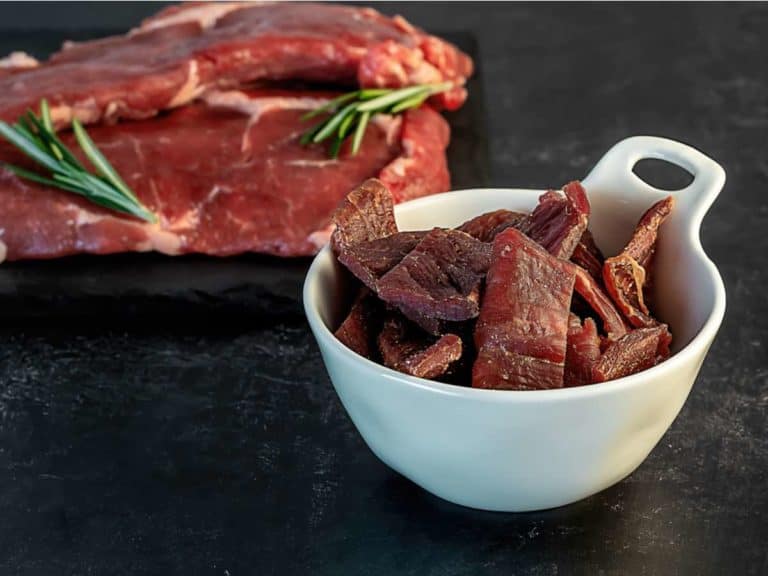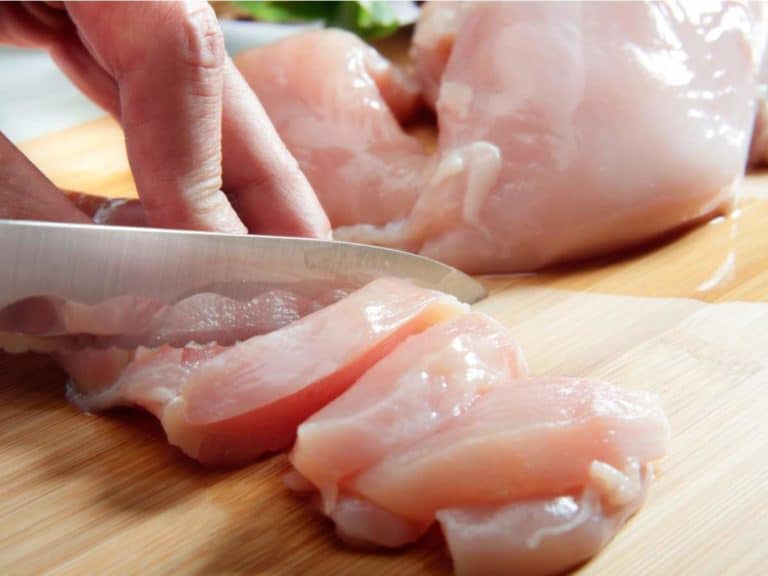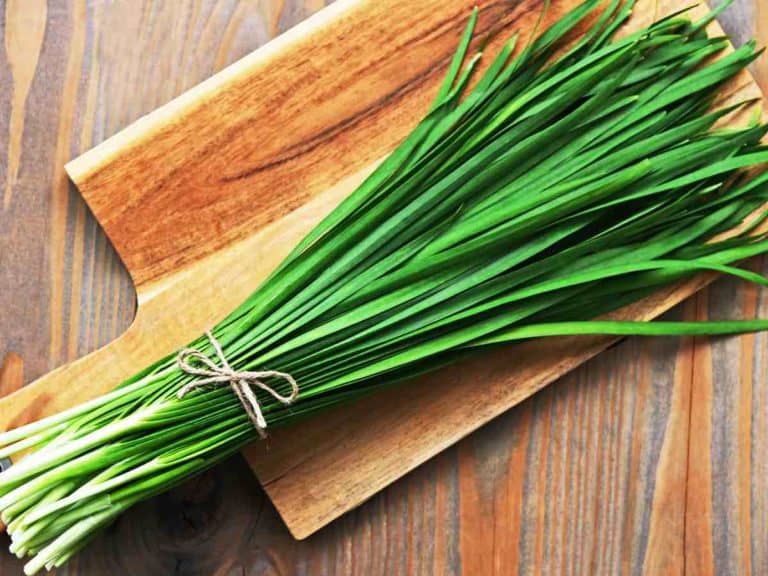How to Get Rid Of Weevils Without Damaging Rice
It is said that you will probably ingest rice weevils — adults, larvae and eggs alike — at least once in your lifetime. It doesn’t matter whether or not rice is a staple in your diet since those tiny bugs can infest a variety of grain products. Worry not because rice weevils are not known to transmit diseases. Still, they’re gross!
Commercial and professional bug sprays exterminate rice weevils at different life stages. Freezing at 32°F (0°C) for 3 days or heating at 32°F (60°C) for 15 minutes contaminated product kills present rice weevils. There are many ways to keep rice weevils at bay with natural repellents and storage containers.
Rice weevils can spread really fast as adult females can lay multiple eggs per day. So, in other words, if you spot a few, it won’t take long before your pantry is already swarming with them!
The good news is that you can get rid of rice weevils on your own, depending on the infestation’s severity.
Below, I will talk you through killing those bugs using chemicals as well as via all-natural methods. I will also mention ways on how you can keep them from coming back and starting an infestation all over again. But first, let’s get you acquainted more with rice weevils since knowing the enemy is a must if you want to win the battle.

About Rice Weevils
It’s important to get to know rice weevils very well if you want to put an infestation under control and prevent it from happening once more. Otherwise, you will end up battling them and flushing money down the drain incessantly.
Besides, not having enough idea of what rice weevils are can cause additional stress and anxiety, which can make matters seem worse than they really are. This is a complete no-no as you may find yourself taking unnecessary actions and even spending a lot of money in an attempt to put the problem under control.
Let’s answer the following rice weevil-related questions that are probably in your mind right now:
What do rice weevils look like?
A small type of beetle, rice weevils measure 3 to 4.6 millimeters in length. They are dark brown or reddish brown to black in color, with some light-colored patches on their thorax and abdomen. The presence of a long snout that extends from their heads differentiates rice weevils from other pantry pests.
Rice weevil larvae, which are around 3 millimeters in length, look like miniature versions of grub worms.
On the other hand, don’t bother finding out what rice weevil eggs look like. That’s because they are practically microscopic in size. What’s more, eggs in stored grain products are typically laid inside the kernels.
Where do rice weevils lay eggs?
It’s usually inside grain kernels where adult female rice weevils lay their eggs. However, rice weevil eggs can also be laid in cracks and crevices in the pantry. It’s because of this exactly why every nook and cranny should be given attention when attempting to deal with a rice weevil infestation.
One of the things that make it difficult for homeowners to take the extermination of rice weevils into their own hands is that failure to kill the eggs, too, can make the problem show up all over again anytime soon.
Therefore it’s important to ensure that professional exterminator-recommended steps are carried out properly.
How many eggs do rice weevils lay?
Adult female rice weevils can lay anywhere between 300 to 400 eggs in their lifetime. Since they live for about 3 to 6 months, as many as 2 to 3 eggs per day can be laid. The eggs, which are usually laid inside grain kernels, hatch in about 3 days, and the larvae emerge from the kernels in about 18 days.
It’s not unlikely for a rice weevil infestation to go from barely there to severe in a matter of weeks.
That’s because rice weevils can multiply rather quickly. As mentioned earlier, a female adult rice weevil can lay up to 400 eggs for the rest of its life cycle — it only takes one female rice weevil for a huge pantry problem to strike!
How long can rice weevils live without food?
Rice weevils can survive without food for a month or sometimes longer. Because adult rice weevils can crawl long distances and fly, too, they can easily invade other food products in the pantry or look for another area to infest. As a result of all these things, it can be hard to put a rice weevil infestation under control.
Despite what they’re called, rice weevils eat other things than just rice. Various grain products are a part of their meal. Rice weevils, in many instances, will also consume bird seed, nuts, dried fruits and even cotton.
But because they can live for a month or so without eating, a food shortage isn’t a very serious issue for them.
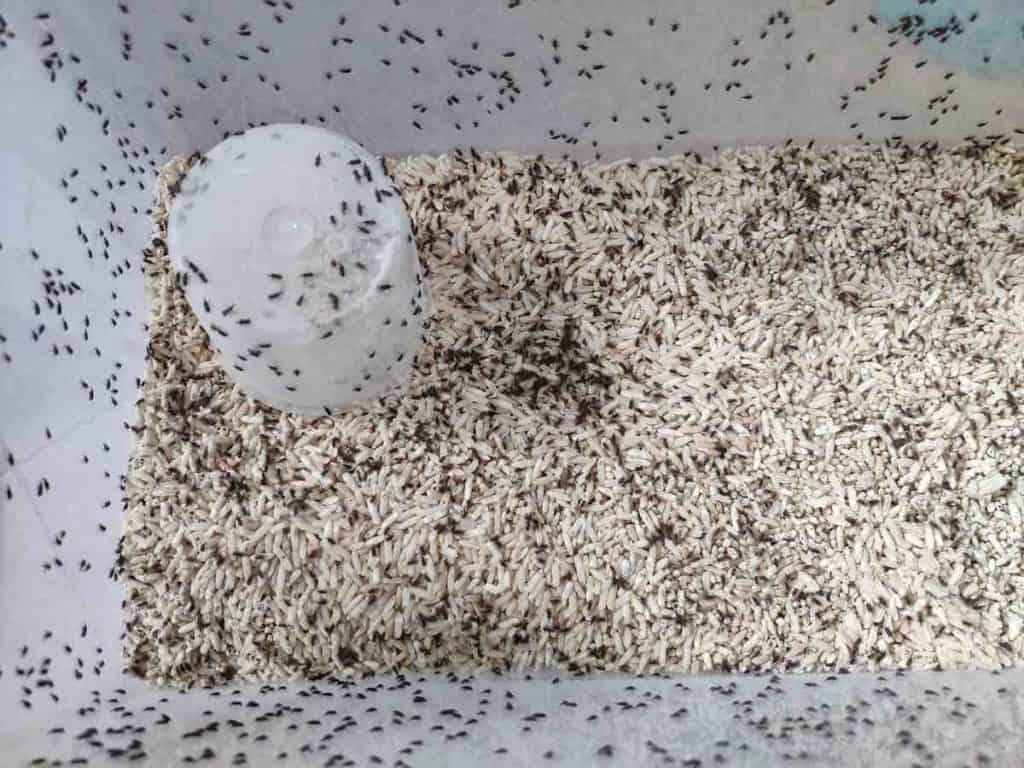
Where do rice weevils in rice come from?
Believe it or not, rice weevils can come from inside grain kernels. That’s because it’s where adult female rice weevils like to lay their eggs. However, rice weevil can also contaminate various food products, including especially those in the pantry from a contaminated item, such as a bag of supermarket-bought rice.
It’s not uncommon for a rice weevil problem at home to stem from bringing home a seemingly harmless supermarket grain product that’s infested with adult or larvae rice weevils or eggs.
Once they escape the packaging, it can be easy for them to invade pantry items that are not securely stored.
How do you tell if rice has weevils?
In some instances, determining whether or not rice has weevils is as simple as observing the item to look for the presence of tiny dark brown, reddish brown or black crawling insects or grub worm-like creatures. In other grain products, holes in their packaging may signal the presence of rice weevils.
Adult rice weevils may be small, but they’re visible to the naked eye. Their dark color also makes them noticeable.
Since the rice weevil eggs are so tiny and usually found inside grain kernels, it’s pointless to determine whether or not a bag of rice that you just purchased at the supermarket is infested with them.
What attracts rice weevils?
Rice weevils are attracted to various grain products and numerous other pantry items. Similarly, they are attracted more to light than darkness. It’s their natural attraction to light that allows them to easily find homes to invade, particularly at night when they can easily spot and be drawn to outdoor lights.
Besides introducing rice weevils into your home by bringing in infested store-bought food products, these tiny pests can also find their way into your kitchen and pantry by following the light — literally.
Once inside your abode, their good sense of smell helps rice weevils figure out where the goods are.
How common are rice weevils?
Among the over 95,000 types of weevils, rice weevils are the most common kinds that infest the pantry. On the planet, rice weevils tend to be more common throughout Asia and Africa where rice and grain crops are widely grown and harvested. A rice weevil infestation is common as the bugs can multiply rapidly.
In the US, other than pantries, cupboards and other areas of the kitchen, rice weevils are also commonly found in processing plants and storage facilities for various grain products.
Because of their diet, it’s safe to assume that rice weevils are common where grains are commonplace.
What happens if you eat rice weevils?
Rice weevils are not known to transmit food-borne diseases. Similarly, they are non-poisonous to humans. So, in other words, nothing will happen if rice weevils are unknowingly or accidentally consumed. This is true whether the grain product with rice weevil — adult, larvae or egg — is cooked or raw when ingested.
It’s no secret that pests such as rats, cockroaches and mosquitoes can spread diseases, even life-threatening ones.
Fortunately, rice weevils are not one of them. One of the reasons for this is that they feast on grain products and not garbage or dead animals. Still, unknowingly consuming them is not a particularly pleasing thought!
What to Do When You Find Weevils in Rice
Determining whether or not an infestation is present is important after finding rice weevils in a bag or rice or a package of a stored grain product. In some instances, it’s generally a good idea to toss out contaminated and potentially contaminated items and administer the right treatment to put the problem under control.
Experts agree that it’s important to deal with an infestation as soon as rice weevil activity is confirmed.
It involves getting rid of rice, grains and other products stored in the area that may also be contaminated — it may be a costly step alright, but it can prevent even more money from going down the drain.
Food items that are actually and potentially infested with rice weevil should be placed in garbage bags, sealed and taken out of the house. The pantry should then be vacuumed in order to get rid of remaining adults, larvae and eggs. Using a brush or crevice attachment in vacuuming corners and joints as well as wall and floor junctures is ideal.
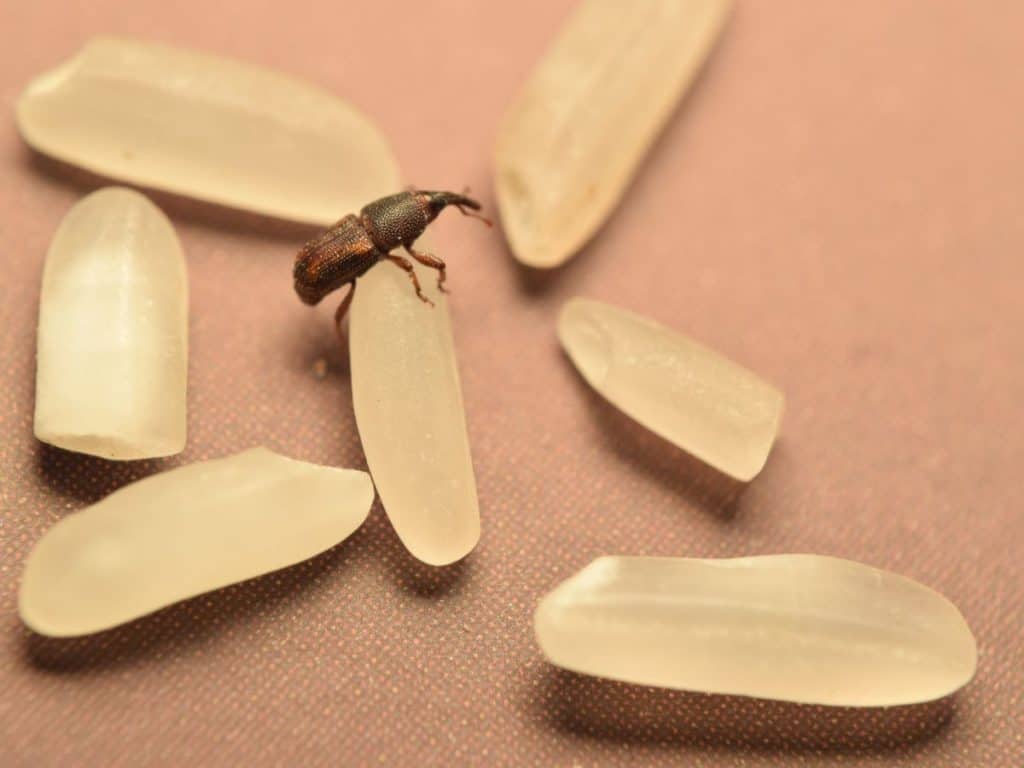
The following chemicals are some of the most recommended by both scientists and pest control experts in dealing with a rice weevil infestation effectively:
Pyrid
Many professional exterminators recommend the use of pyrid for mild rice weevil infestations. That’s because the product contains natural botanical ingredients, which makes it safe for use in areas where food is stored or prepared. Still, food items should be removed or covered when pyrid is being used.
Novacide
Primarily, novacide is used to kill ticks and fleas. However, it’s also proven effective against a variety of pests, including rice weevils. One of the best things about this particular insecticide is that it has an insect growth regulator (IGR) that disrupts the growth of rice weevils, thus keeping them from reproducing and multiplying.
Malathion
Among the 8 insecticides used by rice growers for a scientific investigation, malathion proved to be the most economical and effective in killing rice weevils. A man-made organophosphate insecticide commonly used for controlling pests that attack fruits, malathion can kill all rice weevils within an hour of exposure.
While effective, the insecticides mentioned above cannot be used on food. Needless to say, exterminating weevils with any of them cannot get rid of those that are in food products.
Once they escape, they can easily invade other items and multiply and start an infestation all over again.
In order to be sure, it’s not enough that you use the right chemicals — you should also discard food items stored in the affected area. This is true whether an infestation is confirmed or suspected. Homeowners who refuse to throw away consumables may instead opt for rice weevil management that won’t damage or contaminate them.
How to Kill Weevils Without Damaging Rice
Fortunately for health- and budget-conscious homeowners, there are ways to kill weevils effectively without the use of harmful chemicals and throwing away rice and other products infested with rice weevils. Similarly, there are steps that may be taken in order to repel rice weevils and keep them from doing any more damage.
In dealing with rice weevils naturally, more often than not, there is no need to head outside the home to get your hands on certain items just to be able to put the problem in check.
That’s because everything you will need for the job is most likely to be already in your kitchen!
Below, I will briefly talk about some of the things you may do in order to kill or repel weevils without contaminating rice and other infested products with synthetic chemicals. Feel free to experiment with any of them and opt for the one that seems to deliver results the best and/or go well with your preferences and needs.
Freezing
Storing infested rice in the freezer at 32°F (0°C) for 3 days or more is a surefire way to kill adult weevils as well as both larvae and eggs. The cold won’t damage rice. As a matter of fact, freezing rice is commonly recommended not only as an all-natural pest control method but also to extend the shelf life.
Vinegar
Undiluted vinegar can be sprayed on surfaces in order to exterminate rice weevils. Unlike most commercial and professional insecticides, you may use vinegar near rice and other food products. As a matter of fact, you can spray it directly on food items, although vinegar will surely cause a change in taste and some other qualities.
Ginger or turmeric
Placing a few slices of ginger or turmeric in the container of rice or any other pantry product can help drive away rice weevils — they can’t stand the smell of either herb. You may also leave ginger or turmeric in strategic places in the pantry or kitchen in order to prevent a rice weevil infestation from striking.
Garlic
Besides vampires, garlic can also scare away rice weevils. The powerful pungent odor of this popular culinary and medicinal herb is simply too strong for those bugs. For best results, you may dice or mince fresh garlic cloves, place them in small containers, and leave them around the pantry or kitchen to keep rice weevils off-limits.
Neem or bay leaves
Fret not if you find the smell of garlic too strong even for you. That’s because you may also count on neem leaves, which have a garlic-like smell but milder — put some in containers, cabinets and corners. Many also count on bay leaves. They have an herbal and somewhat floral aroma that can deter rice weevil activity.
Matchsticks
Would you believe that matchsticks are capable of warding off rice weevils? Matchsticks contain sulfur, whose odor rice weevils cannot stand. All you have to do is place a few matchsticks in containers with products rice weevils are very much likely to attack. Do not worry because matchsticks are generally non-toxic.
How to Store Rice to Prevent Weevils
Whether your DIY rice weevil extermination has proved to be effective or your pantry is in constant threat of a rice weevil infestation, it’s important to store rice and other grain products properly. The goal should be to keep rice weevils outside to stop them from snacking on and laying eggs in various pantry or kitchen items.
Rice weevils can easily chew their way in and out of cardboard and paper and plastic bags that many food products come sold in. So, in other words, it’s not a good idea to leave them in their original packaging.
If rice weevils are a threat, always store goods that are at risk in airtight containers.

Thick plastic, glass, metal — no matter the material, a container with an airtight cover or seal is effective in preventing rice weevils from doing their bad deeds. Especially if you live where pantry infestations are commonplace, it’s a good idea to spend money on good quality storage containers to save money in the long run.
Online, you can easily shop for some of the best products for the job. The following are some of those that I highly recommend for you to consider ordering and using:
- Rubbermaid brilliance airtight food storage – If rice is a staple, this particular rice weevil-proof container is recommended. It’s large enough to accommodate up to 12 cups of rice or dry ingredients. Multiple ones are stackable, thus allowing to save precious space while preventing an infestation. My personal favorite.
- MCIRCO 36-piece set airtight food storage containers – Everything comes with an airtight container and is out of BPA-free plastic. Besides the rice weevil-proof containers themselves, a purchase also comes with measuring cups and labels for hassle-free pantry organizing.
- CINEYO 7-piece set clear plastic canisters – Designed with space saving in mind, each piece can be stored not only in the pantry but also refrigerator and freezer, too. The lids lock easily and the containers themselves are easy to clean. To help with organizing, labels and a white marker are included.
- White Feather 2-piece set XXL pantry containers – Those who buy rice and other pantry items in large packaging should consider getting this product, which consists of a couple of 6.6-liter airtight plastic containers. Blue silicone gasket guarantees protection from the elements and pantry pests.
- Uppetly dry food storage container – Able to hold up to 3 liters of rice or any other grain product, it has an airtight lid that can prevent rice weevils and other pests from getting in. The BPA-free plastic container comes with a spout, whose cover doubles as a measuring cup, for easy dispensing each time.
- LocknLock easy essentials flip-up lid container – Coming in different sizes, the largest of the bunch can hold up to 50.7 cups of dry ingredients. One of the nicest things about the product is that it has a flip-up cover for trouble-free dispensing. A purchase comes with a free measuring cup.
Just Before You Protect Your Pantry From Rice Weevils
It’s true that rice weevils won’t harm your health if you accidentally ingest them. Still, it’s not right to add them to your diet, especially without you knowing about it. Fortunately, there are ways to rid your pantry of rice weevils — you can go the professional route by calling exterminators or choose to do things the DIY way.
Above, I mentioned some safe and all-natural ways to exterminate and/or repel rice weevils. It’s also a good idea to store everything in the pantry in airtight containers in order to keep another infestation from happening.

